The Role of IL-15 Deficiency in the Pathogenesis of Virus-Induced Asthma Exacerbations
Rhinovirus infections are the major cause of asthma exacerbations. We hypothesised that IL-15, a cytokine implicated in innate and acquired antiviral immunity, may be deficient in asthma and important in the pathogenesis of asthma exacerbations. We investigated regulation of IL-15 induction by rhinovirus in human macrophages in vitro, IL-15 levels in bronchoalveolar lavage (BAL) fluid and IL-15 induction by rhinovirus in BAL macrophages from asthmatic and control subjects, and related these to outcomes of infection in vivo. Rhinovirus induced IL-15 in macrophages was replication-, NF-κB- and α/β interferon-dependent. BAL macrophage IL-15 induction by rhinovirus was impaired in asthmatics and inversely related to lower respiratory symptom severity during experimental rhinovirus infection. IL-15 levels in BAL fluid were also decreased in asthmatics and inversely related with airway hyperresponsiveness and with virus load during in vivo rhinovirus infection. Deficient IL-15 production in asthma may be important in the pathogenesis of asthma exacerbations.
Published in the journal:
. PLoS Pathog 7(7): e32767. doi:10.1371/journal.ppat.1002114
Category:
Research Article
doi:
https://doi.org/10.1371/journal.ppat.1002114
Summary
Rhinovirus infections are the major cause of asthma exacerbations. We hypothesised that IL-15, a cytokine implicated in innate and acquired antiviral immunity, may be deficient in asthma and important in the pathogenesis of asthma exacerbations. We investigated regulation of IL-15 induction by rhinovirus in human macrophages in vitro, IL-15 levels in bronchoalveolar lavage (BAL) fluid and IL-15 induction by rhinovirus in BAL macrophages from asthmatic and control subjects, and related these to outcomes of infection in vivo. Rhinovirus induced IL-15 in macrophages was replication-, NF-κB- and α/β interferon-dependent. BAL macrophage IL-15 induction by rhinovirus was impaired in asthmatics and inversely related to lower respiratory symptom severity during experimental rhinovirus infection. IL-15 levels in BAL fluid were also decreased in asthmatics and inversely related with airway hyperresponsiveness and with virus load during in vivo rhinovirus infection. Deficient IL-15 production in asthma may be important in the pathogenesis of asthma exacerbations.
Introduction
Rhinovirus (RV) infections in healthy individuals manifest as common colds but in asthma are strongly associated with acute exacerbations [1], [2]. Type I (α/β), II (γ) and III (λ) interferon (IFN) responses are important in anti-viral immunity and increased susceptibility to RV infection has been demonstrated in asthma in vivo [2], [3]. RV infection of asthmatic bronchial epithelial cells (BEC) in vitro resulted in reduced IFN-β and -λ production and increased viral replication [4], [5]. Monocytes/macrophages are also infected and activated by RV [6] and macrophage IFN-λ production is also impaired in asthma and related to asthma exacerbation severity and virus load in vivo [5]. Bronchoalveolar lavage (BAL) cell IFN-γ induction by RV is also impaired in asthma and related to exacerbation severity in vivo [3].
IL-15 is important in linking innate and adaptive antiviral immune responses, promoting natural killer (NK) and memory CD8 T cell anti-viral immune responses [7], [8] and monocytes/macrophages produce IL-15 in response to virus infections [7]-[10]. There is little reported data on IL-15 in asthma. IL-15 mRNA expression levels in bronchial biopsies in asthma are not increased [11], while protein levels in sputum are undetectable in normal subjects and steroid naïve asthmatics, but detectable in steroid-treated asthmatics [12]. There is a single report that IL-15 gene expression is increased in asthma exacerbations in children [13] but no data on IL-15 in RV infections. Since (i) α/βIFNs are reported to induce IL-15 in dendritic cells and monocytes [14], [15], (ii) RV induction of IFN-β is reported deficient in asthma [4], (iii) IL-15 is important in innate and acquired antiviral immunity and (iv) there is increased susceptibility to RV infection in asthma [1]–[3] we hypothesized that IL-15 production may be deficient in asthma and related to asthma exacerbation pathogenesis.
We have therefore tested the hypotheses that RV infection of macrophages in vitro induces IL-15 production and that this is mediated by α/β IFNs and the transcription factor nuclear factor-κB (NF-κB). In addition, we determined whether RV induction of IL-15 ex vivo is deficient in macrophages from asthmatic subjects and whether IL-15 levels in BAL fluid are deficient in asthma. We also investigated whether IL-15 deficiency in asthma is related to parameters of severity and virus load during experimental RV16 infection in vivo.
Results
RV up-regulates IL-15 production in macrophages
To investigate whether RV induces IL-15 release from macrophages we used two models of monocyte-derived macrophages in which RV induces replication-dependent activation [6]. We did not measure virus replication in this study however we have previously reported that rhinovirus replication was productive in THP-1 macrophages, leading to release of infectious virus into supernatants, but was limited in monocyte-derived macrophages [6]. IL-15 protein release into supernatants was significantly induced by RV16, at 48 and 72 hours for THP-1-derived macrophages and between 24 and 72 hours for monocyte-derived macrophages (Figure 1A and B). RV9 (major group) and RV1B (minor group) also induced IL-15 release from THP-1-derived macrophages (Figure 1C) indicating that IL-15 induction was not RV serotype- or receptor-dependent. IL-15 release was reduced significantly by UV-inactivation, confirming that induction was largely replication-dependent (Figure 1C).

Because IL-15 protein can be stored intracellularly in macrophages and virus infection could simply trigger the release of preformed protein we next investigated whether RV infection up-regulated IL-15 mRNA expression and found that IL-15 mRNA was significantly induced by RV at 24 hours and 48 hours (Figure 1D).
NF-κB activation is required for IL-15 induction in RV-infected macrophages
The IL-15 promoter has been shown to have binding sites for nuclear factor (NF)-κB and interferon regulatory factors (IRFs) which are important for its activation by other stimuli [10], [16]–[18]. To assess the role of NF-κB in RV-induced IL-15 production we inhibited activation of the NF-κB pathway with a NF-κB pharmacological inhibitor (AS602868) [6] at the time point of maximal IL-15 production. We used the IKK2 inhibitor AS602868 at a concentration of 5 µM, which we have previously shown to be optimal for rhinovirus induced TNF-α inhibition and without cell toxicity [6].
RV16-induced IL-15 production was significantly decreased in THP-1-derived macrophages (p<0.01) and monocyte-derived macrophages (p<0.01) (Figure 2A and B) in the presence of the NF-κB inhibitor, confirming that RV-induction of IL-15 was NF-κB-dependent in both cell types.
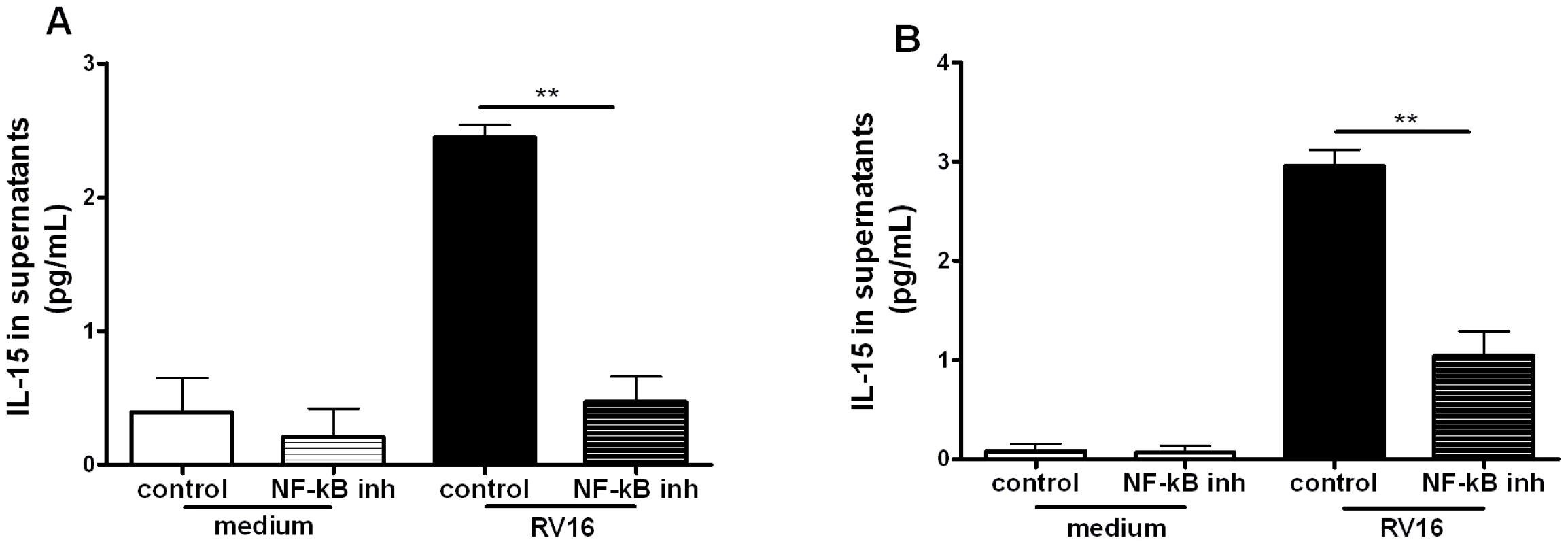
IFN-α/β induction in RV-infected macrophages is dependent on NF-κB
As α/β IFNs are induced during viral infections and are implicated in IL-15 induction in other systems, we next investigated RV induction of IFN-α/β in macrophages. RV16 infection induced IFN-β production at 8 and 48 hours (p<0.05), peaking at 24 hours (p<0.001, Figure 3A) while IFN-α was induced at 24 hours (p<0.001) and 48 hours (p<0.01, Figure 3B). RV9 and RV1B induced similar levels confirming that IFN-α/β production in macrophages is not serotype- or receptor-dependent and UV-inactivation completely abolished IFN-α/β induction demonstrating that induction is replication-dependent (Figure 3C and D). RV induction of IFN-α/β was also dependent on NF-κB activation as the NF-κB inhibitor markedly decreased RV-induction of IFN-β and IFN-α (Figure 3E and F, both p<0.01).
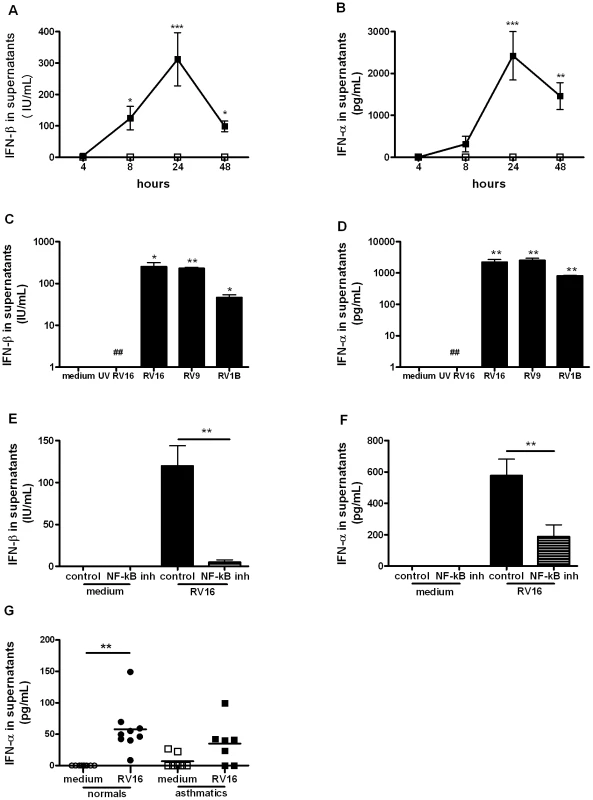
We previously reported that there is deficient IFN-β production in bronchial epithelial cells in asthmatics upon RV infection [4] and that macrophage production of IFN-λ was similarly deficient [5]. Therefore we wished to investigate if type I IFN production is also deficient in alveolar macrophages from asthmatics. Cells were obtained with bronchoalveolar lavage and the composition of the lavage was ∼90% macrophages in all subjects with no differences in cellular composition between the asthmatics and the non-asthmatics [5]. In vitro RV16 infection of BAL cells induced significantly higher IFN-α levels compared with medium in normal subjects (p<0.01) but infection of BAL cells from asthmatics did not result in significantly up-regulated IFN-α levels (Figure 3G). IFN-α levels produced by BAL cells from normals were higher than levels from asthmatics but this difference was not statistically significant (p = 0.09). No IFN-β could be detected in supernatants of BAL cells at the 48 hour time point studied in either normal or asthmatic subjects.
We attempted to confirm deficient production of these IFNs in vivo, by measuring IFN-α and IFN-β directly in BAL fluid. Despite using up to 30x concentrated BAL fluid, no IFN-α or IFN-β could be detected in BAL fluid taken at the baseline, day 4 post-RV16 infection or the convalescence bronchoscopies.
RV induction of IL-15 in macrophages is IFN-α/β dependent
Having demonstrated that RV induces IL-15 and IFN-α/β production we next investigated whether IFN-α/β signalling is required for RV induction of IL-15 in macrophages. Firstly we investigated whether IFN-β could induce IL-15 secretion in macrophages and found that recombinant human IFN-β induced IL-15 secretion from both THP-1-derived and monocyte-derived macrophages in a dose dependent manner (Figure 4A). Using a blocking antibody against the IFN-α-receptor subunit 2 (IFNAR2) we found that RV16-induced IL-15 production was almost completely inhibited by blocking antibody, but not isotype control in both THP-1-derived and monocyte-derived macrophages (Figure 4B and C, p<0.01 and p<0.001 respectively). Since interferon regulatory factor-1 (IRF-1) is induced by type I IFN [19] and regulates IL-15 gene transcription in other systems [20] we next investigated IRF-1 protein induction by RV. Unstimulated THP-1-derived macrophages expressed low levels of IRF-1, however both IFN-β and RV16 increased IRF-1 intracellular protein levels as early as 4 hours, both remaining elevated to 24 hours (Figure 4D). Blocking the IFNAR, but not isotype control markedly inhibited IRF-1 induction by RV16 (Figure 4E), confirming that the IFN-α/β-IFNAR pathway was also required for IRF-1 activation by RV in macrophages.
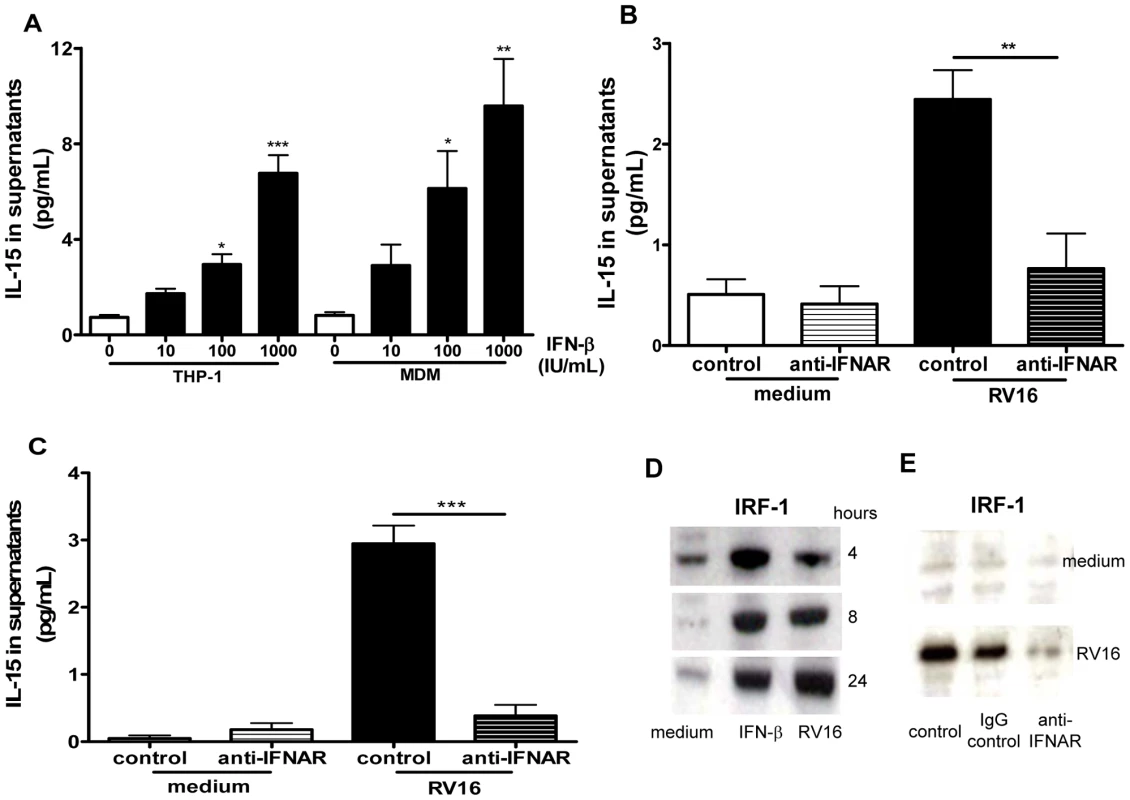
RV induces IL-15 production in alveolar macrophages ex vivo; induction is deficient in asthma and related to lower respiratory symptom severity during RV infection
Having shown that RV infection induces IL-15 in two macrophage models in vitro we next investigated if induction is observed in alveolar macrophages infected ex vivo and whether induction is deficient in asthmatics. Supernatants from BAL cells (>90% alveolar macrophages) from normal and asthmatic subjects exposed ex vivo to RV16 for 48 hours were assessed for levels of IL-15 by ELISA. IL-15 levels were significantly increased by RV16 in BAL cells from normal subjects (p<0.05), but not in cells obtained from asthmatics, and levels in supernatants from RV16-infected cells were significantly higher in normal compared to asthmatic subjects (Figure 5A, p<0.01). IL-15 production by RV infected macrophages was inversely related to lower respiratory symptom severity on subsequent RV16 experimental infection in the same subjects in vivo (r = −0.6, p = 0.022, Figure 5B). Although IL-15 levels were very low, they were above the lower limit of detection (0.25 pg/mL) and differences observed were both statistically significant and related to a number of different clinical parameters.
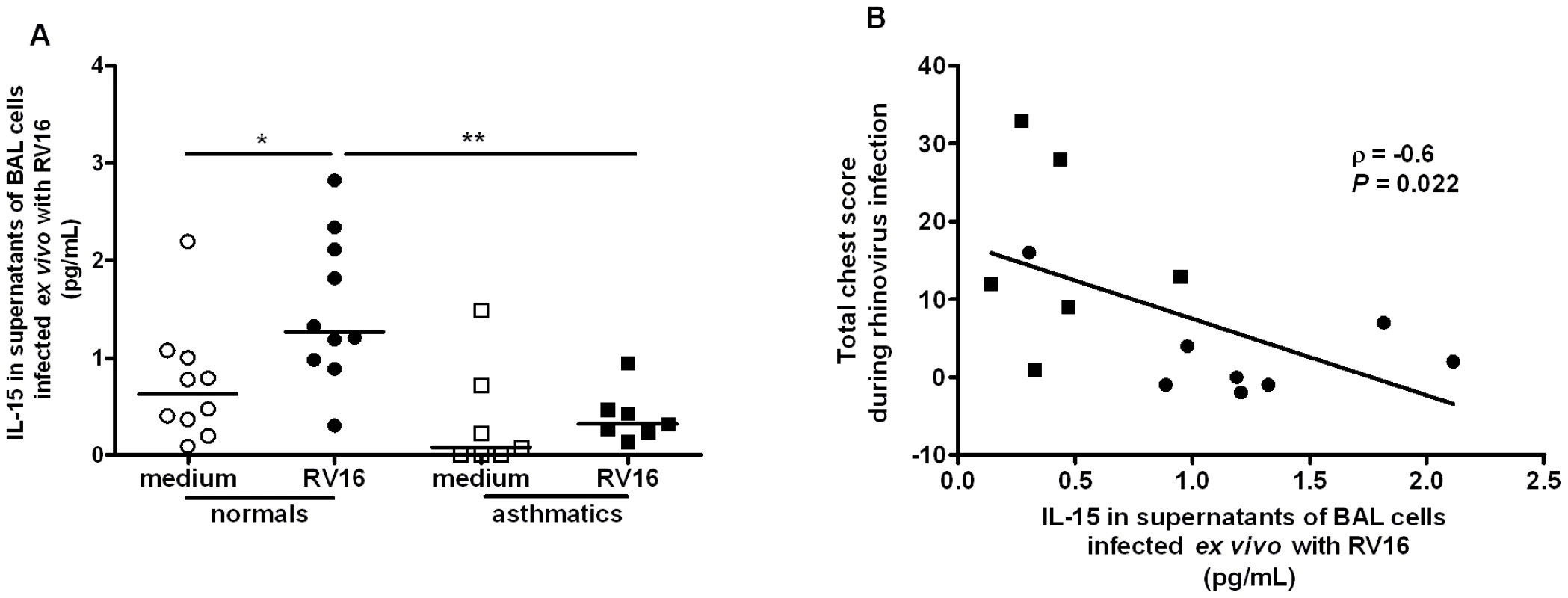
BAL IL-15 levels are deficient in asthmatics and related to airway hyperresponsiveness and virus load during subsequent RV infection in vivo
To investigate whether IL-15 levels are deficient in asthma in vivo, IL-15 was measured in BAL fluid collected from asthmatic and normal subjects when clinically stable prior to experimental RV16 infection. The study recruited 15 non-atopic healthy and 10 atopic mild asthmatic subjects, all rhinovirus-16 serum neutralizing antibody negative and all non-smokers. The healthy control group had a median age of 24, sex ratio 8 male/7 female and a median baseline FEV1% predicted of 99% and the asthmatic subjects were inhaled steroid naïve, median age of 22, sex ratio 2 male/8 female and a median baseline FEV1% predicted of 104% as previously reported [3].
IL-15 levels were significantly lower in asthmatic compared to normal subjects (Figure 6A, p<0.05) and were significantly correlated with airway hyperresponsiveness as measured by baseline PC10 histamine (r = 0.47, p = 0.021, Figure 6B). IL-15 levels in vivo were also significantly related to virus loads in nasal lavage (r = −0.57, p = 0.005), induced sputum (r = −0.44, p = 0.041) and BAL (r = −0.61, r = 0.024) upon subsequent in vivo RV16 experimental infection in the same subjects (Figure 6C–E).
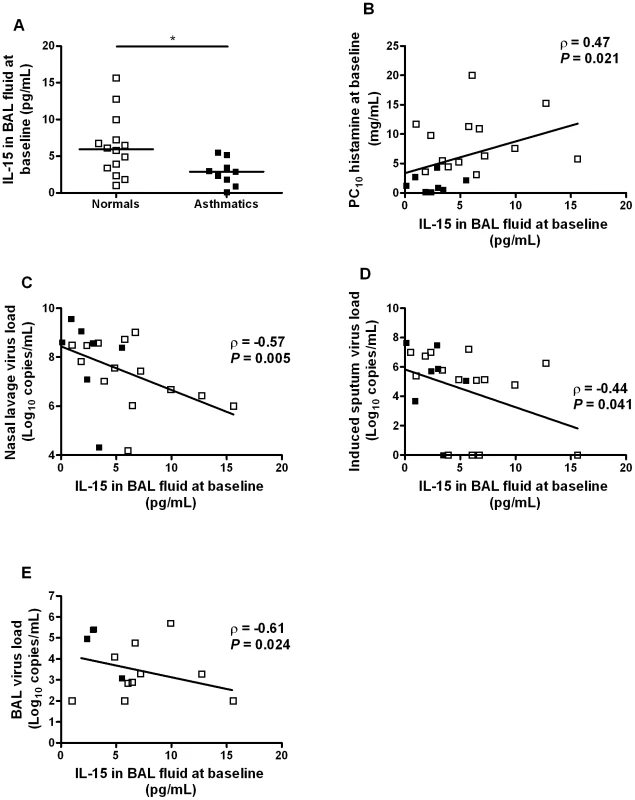
Discussion
We report herein the first investigation of the role of IL-15 in the pathogenesis of RV-induced asthma exacerbations. IL-15 production was induced by RV in macrophage cell lines in vitro, as well as in primary alveolar macrophages. IL-15 induction by RV was deficient in cells from asthmatic compared to normal subjects and levels in BAL fluid deficient in asthmatics. IL-15 induction ex vivo and levels in vivo were both related to airway hyperresponsiveness, lower respiratory symptom severity and virus load following experimental RV16 infection in vivo. Finally, IL-15 induction was dependent on IFN-α/β and both IL-15 and IFN-α/β induction were dependent on NF-κB.
These findings have important implications as they suggest IL-15 as a novel candidate for development for treatment or prevention of asthma exacerbations. As IL-15 is deficient in asthma this suggests either or both of prophylactic or therapeutic treatment approaches may have value. Further, IL-15 inducers such as IFN-β may have additional benefit beyond directly enhancing anti-viral immunity in bronchial epithelium, since, via induction of IL-15 production, they may enhance other aspects of both innate and acquired anti-viral immunity. Finally, NF-κB inhibitors are in development as possible therapies for asthma exacerbations, our data that IFN-α, IFN-β and IL-15 induction by RV are all NF-κB dependent suggest that such approaches may further impair already deficient responses in asthma.
Rhinoviruses are the respiratory viruses most commonly associated with asthma exacerbations. Asthma is the most common chronic respiratory disease, and it is increasing in many countries. The major cause of asthma related morbidity and mortality are acute exacerbations and current asthma treatments are only partially effective at preventing asthma exacerbations. Therefore, new approaches to treatment and prevention are urgently required and these are likely to stem from a better understanding of the pathogenesis of asthma exacerbations.
Asthma exacerbation pathogenesis is poorly understood, however, it is clear that people with asthma have increased susceptibility to respiratory virus infections [2], [3]. We have previously reported deficient IFN-β and IFN-λ production in response to RV infection of bronchial epithelial cells in asthmatics [4], [5], further these deficiencies were related to increased RV replication in the same cells, and replacement with exogenous IFN-β restored normal resistance to RV infection. Deficiency of IFN-λ induction by RV was observed in macrophages from asthmatic subjects, and this was related to virus load, asthma exacerbation severity and severity of airway inflammation in vivo [5]. These findings led to inhaled IFN-β being developed as a possible novel therapy to treat/prevent asthma exacerbations – currently in a Phase II clinical trial.
We have also recently reported deficient IFN-γ production in asthma and related impaired IFN-γ production to greater virus loads and reductions in lung function in a human model of asthma exacerbation in vivo [3]. IFN-γ is produced by both innate and acquired arms of the antiviral immune system. As IL-15 is also important in linking innate and adaptive antiviral immune responses, and in other systems, has been shown to be induced by type I IFNs we wished to investigate the hypothesis that IL-15 might also be deficient in asthma, and that deficiency might be related to the pathogenesis of asthma exacerbations.
Alveolar macrophages are important immune cells in lung antiviral immune responses and we previously reported that monocytes/macrophages support RV replication, become activated and secrete immunomodulatory cytokines [3], [6], [21], [22]. However, there are no published data on IL-15 induction in macrophages by RV, nor on its possible importance in the pathogenesis of asthma exacerbations. Consequently, we investigated macrophage IL-15 and type I IFN responses during RV infection in vitro and in vivo, in both asthmatic and normal subjects.
The most important findings of this study are the deficient induction of IL-15 by RV in alveolar macrophages from asthmatic subjects in vitro, deficient IL-15 levels in asthma in BAL fluid in vivo, and the relationships of these to airway hyperresponsiveness, severity of symptoms and virus load on subsequent RV infection in vivo. The correlations between IL-15 levels in BAL fluid at baseline and PC10 histamine at baseline and virus load during an experimental rhinovirus infection were only statistically significant when all subjects were included. There were no significant correlations within the group of asthmatic subjects alone, presumably due to the low numbers of asthmatic patients included, and larger studies are required to confirm the link between asthma exacerbation pathogenesis, virus replication and IL-15. However these findings taken together suggest IL-15 as a promising candidate for development as a novel therapy to enhance deficient antiviral immunity in asthma, to correct the increased susceptibility to virus infection present in this condition [2], [3] and in particular as a potential treatment to prevent/treat asthma exacerbations.
IL-15, via the IL-2/IL-15 receptor β-chain and common γ chain receptor, promotes NK cell activation, as well as enhancing memory CD8 T cell antiviral immunity [7], [8], [23]. In addition it enhances type I (α/β) IFN production by dendritic cells and macrophages [24], [25] as well as IFN-γ production by NK and CD8 T cells [7], [8], [26]. Since induction of both IFN types is deficient in asthma and related to asthma exacerbation severity, IL-15 has potential to correct deficiencies present in antiviral immunity in asthma.
Our findings also have important implications for development of type I IFNs as potential therapies for asthma exacerbations, as we show that RV infection of macrophages induces α/β IFNs, that IL-15 is induced by IFN-β stimulation and that RV induction of IL-15 in macrophages is dependent on IFN-α/β receptor signalling. These data suggest that administration of α/β IFNs in asthma is likely to enhance IL-15 baseline levels, as well as enhancing induction upon RV infection, both of which we have shown to be deficient in this report. Type I IFN administration might therefore have benefits well beyond correcting the specific deficit in anti-viral immunity in bronchial epithelial cells, indirectly enhancing deficient IFN-γ production, as well as other NK and CD8 responses via correction of deficient IL-15 production.
These findings also have important implications for development programmes for inhibitors of NF-κB [27]. This transcription factor is implicated in many pro-inflammatory responses linked with the pathogenesis of asthma exacerbations and many pharmaceutical companies have active NF-κB inhibitor development programmes. However we find that RV induction of IFN-α, IFN-β and IL-15 are all profoundly suppressed by inhibition of NF-κB. These data suggest that administration of such inhibitors in asthma, while inhibiting pro-inflammatory mediator production, is likely to further impair deficient type I IFN and IL-15 production, and therefore might have potential to increase rather than decrease severity of virus induced asthma exacerbations. Careful investigation of these outcomes, as well as their relationships with clinical outcomes in human models of RV-induced asthma exacerbations [3] may shed further light on these possibilities.
Because signalling by IL-15 occurs via the IL-2/IL-15 receptor β-chain (CD122) and common γ chain receptor (CD132) expressed primarily by NK and memory CD8 T cells [7], [8], [23], [26], it will be of great interest to determine the levels of these receptors on airway NK and CD8 T cells in virus-induced asthma.
Finally, our findings of deficient IL-15 production in asthma, combined with previous reports of deficient IFN-β [4], IFN-λ [5], IFN-γ and IL-12 [3], [22], suggest complex impairment of anti-viral immune responses in asthma. The mechanisms behind these complex deficiencies clearly require urgent investigation. These findings also have major implications for management of pandemic influenza, where asthma is a major risk factor for severe disease and death [28], as replacing deficient anti-viral immune proteins such as IFN-β and now IL-15, may have therapeutic potential to ameliorate severity of disease and perhaps prevent death.
Materials and Methods
Cells, viruses and cell infection/stimulation
HeLa and THP-1 cell lines (ECCC) were cultured in E-MEM and RPMI-1640 (Invitrogen, Paisley, UK) respectively with 10% foetal calf serum (FCS). RV serotype 16, 9 (major group) and 1B (minor group) stocks were prepared and their identities confirmed by neutralisation using serotype-specific antibodies (ATCC), UV-inactivation was performed as previously described [29]. Peripheral blood monocyte-derived macrophages and THP-1-derived macrophages were generated and infected with RV at a multiplicity of infection (MOI) of 1 as previously described [6]. Recombinant human IFN-β (10–1000 IU/mL, R&D, Abingdon, UK) was added to wells. Supernatants, RNA or protein lysates were harvested and stored at −80°C.
IL-15 mRNA quantification
Total RNA was extracted with RNeasy Kit (Qiagen) and 2 µg was used for cDNA synthesis (Omniscript RT Kit, Qiagen). Quantitative RT-PCR was performed using specific primers and probe for IL-15 (forward GGGAAAGTGATGTTCACCCC, reverse CATCTCCGGACTCAAGTGAAATAA, probe ATCTGGATGCAAAGAATGTGAGGAACTGGA). IL-15 gene expression was normalized to 18S rRNA and presented as fold induction relative to medium [30].
Ethics statement
Ethics approval (No 99/BA/345) was obtained from St Mary's Local Research Ethics Committee, London, UK. All study participants gave written informed consent.
Human experimental model of RV-induced asthma exacerbation
The exacerbation model, clinical details including allergy testing and lung function, sampling and analysis are described in detail elsewhere [3]. The study recruited 15 non-atopic healthy control and 10 atopic, inhaled steroid naïve asthmatic subjects; all were non-smokers. Assessment of airway hyperresponsiveness by determination of the provocative concentration of histamine inducing a 10% fall in FEV1 (PC10 histamine) and BAL were performed at baseline ∼2 weeks prior to experimental RV infection as described [3]. Baseline BAL fluid was collected in a single plastic chamber and transferred immediately to polypropylene tubes on ice, transported to the laboratory, filtered (100 µm), centrifuged at 1500 rpm for 10 min at 4°C, the fluid decanted, aliquoted and stored at −80°C till analysed. Because we could not detect IL-15 in un-concentrated BAL fluid, we concentrated the BAL fluid 30 times as described below. Baseline BAL cells were cultured and exposed to RV16 MOI 5/medium as described [3]. After 48 hours, supernatants were harvested and stored at −80°C.
Virus load on days 1–8 and 11 post-infection for nasal lavage, on day 3 post-infection for sputum and on day 4 post-infection for BAL were determined using quantitative PCR as described [3]. Lower respiratory symptom severity during the two weeks post infection was derived using a chest symptom score as described [3].
BAL fluid concentration for IL-15 ELISA
IL-15 levels were measured after concentrating the baseline BAL fluid up to 30 times using a centrifugal filter with a nominal molecular weight value of 3000 kD (Millipore, Centriplus YM-3). Values were corrected for variability in dilution during lavage, and during subsequent concentration using total protein concentration of the concentrated BAL (Bradford method, Sigma) [31].
Western blot for IRF-1 expression
THP-1-derived macrophages were lysed into SDS sample buffer (Invitrogen). Western blot was performed as previously described [6]. After blocking, membranes were incubated with rabbit anti-human IRF-1 (1/500) followed by HRP swine anti-rabbit antibody (1/4000) (AbD Serotec). Bands were visualized by chemiluminescence with the ECL Western blotting detection reagent (GE Healthcare).
IL-15, IFN-α and IFN-β ELISA
Levels of IFN-α and IFN-β were measured using ELISA kits (BioSource International) (sensitivity 15 pg/mL and 5 IU/mL respectively). For the IL-15 ELISA we used commercially available paired antibodies (R&D Systems) at concentrations recommended by the manufacturer and for the standard curve recombinant human IL-15 (Biosource). The protocol recommended by the manufacturer was modified by incubating the plates for 10 minutes with streptavidin-HRP (Biosource) at a concentration of 0.5 µg/mL. A TMB containing substrate solution was used to develop the colour. Once optimised, we could reproducibly detect levels of IL-15 over 0.25 pg/mL.
NF-κB and IFN - IFN-receptor pathway inhibition
The effect of NF-κB activation on IL-15 production was evaluated using a NF-κB inhibitor (AS602868) as previously described [6]. The role of type I interferons in IL-15 production was assessed using a blocking antibody to IFNAR2, a matched isotype antibody was used as control (Merck Chemicals). Cells were pre-treated for 1 hour before infection with IFNAR2 blocking antibody/isotype control at a concentration of 5 µg/mL. The same concentration of antibody was added to the medium after infection.
Statistical analysis
The results were analyzed using GraphPad Prism version 4.00 for Windows (GraphPad Software, California, USA). For in vitro experiments results expressed as mean±standard error of the mean (SEM) and analyzed using ANOVA for multiple comparisons followed where appropriate by paired Student's t tests for paired comparisons. Differences between normal and asthmatic groups were analysed using Mann Whitney tests and correlations using Spearman's rank correlation.
Zdroje
1. JohnstonSLPattemorePKSandersonGSmithSLampeF 1995 Community study of role of viral infections in exacerbations of asthma in 9-11 year old children. BMJ 310 1225 1229
2. CorneJMMarshallCSmithSSchreiberJSandersonG 2002 Frequency, severity, and duration of rhinovirus infections in asthmatic and non-asthmatic individuals: a longitudinal cohort study. Lancet 359 831 834
3. MessageSDLaza-StancaVMalliaPParkerHLZhuJ 2008 Rhinovirus-induced lower respiratory illness is increased in asthma and related to virus load and Th1/2 cytokine and IL-10 production. Proc Natl Acad Sci U S A 105 13562 13567
4. WarkPAJohnstonSLBucchieriFPowellRPuddicombeS 2005 Asthmatic bronchial epithelial cells have a deficient innate immune response to infection with rhinovirus. J Exp Med 201 937 947
5. ContoliMMessageSDLaza-StancaVEdwardsMRWarkPA 2006 Role of deficient type III interferon-lambda production in asthma exacerbations. Nat Med 12 1023 1026
6. Laza-StancaVStanciuLAMessageSDEdwardsMRGernJE 2006 Rhinovirus replication in human macrophages induces NF-kappaB-dependent tumor necrosis factor alpha production. J Virol 80 8248 8258
7. CarsonWERossMEBaiocchiRAMarienMJBoianiN 1995 Endogenous production of interleukin 15 by activated human monocytes is critical for optimal production of interferon-gamma by natural killer cells in vitro. J Clin Invest 96 2578 2582
8. FawazLMSharif-AskariEMenezesJ 1999 Up-regulation of NK cytotoxic activity via IL-15 induction by different viruses: a comparative study. J Immunol 163 4473 4480
9. MussoTCalossoLZuccaMMillesimoMRavarinoD 1999 Human monocytes constitutively express membrane-bound, biologically active, and interferon-gamma-upregulated interleukin-15. Blood 93 3531 3539
10. EnnaciriJAhmadRMenezesJ 2007 Interaction of monocytic cells with respiratory syncytial virus results in activation of NF-kappaB and PKC-alpha/beta leading to up-regulation of IL-15 gene expression. J Leukoc Biol 81 625 631
11. MuroSTahaRTsicopoulosAOlivensteinRTonnelAB 2001 Expression of IL-15 in inflammatory pulmonary diseases. J Allergy Clin Immunol 108 970 975
12. Komai-KomaMMcKayAThomsonLMcSharryCChalmersGW 2001 Immuno-regulatory cytokines in asthma: IL-15 and IL-13 in induced sputum. Clin Exp Allergy 31 1441 1448
13. BoscoAEhteshamiSSternDAMartinezFD 2010 Decreased activation of inflammatory networks during acute asthma exacerbations is associated with chronic airflow obstruction. Mucosal Immunol 3 399 409
14. MatteiFSchiavoniGBelardelliFToughDF 2001 IL-15 is expressed by dendritic cells in response to type I IFN, double-stranded RNA, or lipopolysaccharide and promotes dendritic cell activation. J Immunol 167 1179 1187
15. Gary-GouyHLebonPDalloulAH 2002 Type I interferon production by plasmacytoid dendritic cells and monocytes is triggered by viruses, but the level of production is controlled by distinct cytokines. J Interferon Cytokine Res 22 653 659
16. WashizuJNishimuraHNakamuraNNimuraYYoshikaiY 1998 The NF-kappaB binding site is essential for transcriptional activation of the IL-15 gene. Immunogenetics 48 1 7
17. TaniguchiTOgasawaraKTakaokaATanakaN 2001 IRF family of transcription factors as regulators of host defense. Annu Rev Immunol 19 623 655
18. AhmadREnnaciriJCordeiroPEl BassamSMenezesJ 2007 Herpes simplex virus-1 up-regulates IL-15 gene expression in monocytic cells through the activation of protein tyrosine kinase and PKC zeta/lambda signaling pathways. J Mol Biol 367 25 35
19. SirenJPirhonenJJulkunenIMatikainenS 2005 IFN-alpha regulates TLR-dependent gene expression of IFN-alpha, IFN-beta, IL-28, and IL-29. J Immunol 174 1932 1937
20. TamuraTYanaiHSavitskyDTaniguchiT 2008 The IRF family transcription factors in immunity and oncogenesis. Annu Rev Immunol 26 535 584
21. PapadopoulosNGStanciuLAPapiAHolgateSTJohnstonSL 2002 Rhinovirus-induced alterations on peripheral blood mononuclear cell phenotype and costimulatory molecule expression in normal and atopic asthmatic subjects. Clin Exp Allergy 32 537 542
22. PapadopoulosNGStanciuLAPapiAHolgateSTJohnstonSL 2002 A defective type 1 response to rhinovirus in atopic asthma. Thorax 57 328 332
23. BeckerTCWherryEJBooneDMurali-KrishnaKAntiaR 2002 Interleukin 15 is required for proliferative renewal of virus-specific memory CD8 T cells. J Exp Med 195 1541 1548
24. JinushiMTakeharaTTatsumiTKantoTGrohV 2003 Autocrine/paracrine IL-15 that is required for type I IFN-mediated dendritic cell expression of MHC class I-related chain A and B is impaired in hepatitis C virus infection. J Immunol 171 5423 5429
25. FoongYYJansDARolphMSGahanMEMahalingamS 2009 Interleukin-15 mediates potent antiviral responses via an interferon-dependent mechanism. Virology 393 228 237
26. KutzlerMARobinsonTMChattergoonMAChooDKChooAY 2005 Coimmunization with an optimized IL-15 plasmid results in enhanced function and longevity of CD8 T cells that are partially independent of CD4 T cell help. J Immunol 175 112 123
27. EdwardsMRBartlettNWClarkeDBirrellMBelvisiM 2009 Targeting the NF-kappaB pathway in asthma and chronic obstructive pulmonary disease. Pharmacol Ther 121 1 13
28. JainSKamimotoLBramleyAMSchmitzAMBenoitSR 2009 Hospitalized patients with 2009 H1N1 influenza in the United States, April-June 2009. N Engl J Med 361 1935 1944
29. JohnstonSLPapiABatesPJMastronardeJGMonickMM 1998 Low grade rhinovirus infection induces a prolonged release of IL-8 in pulmonary epithelium. J Immunol 160 6172 6181
30. HewsonCAEdbrookeMRJohnstonSL 2004 PMA induces the MUC5AC respiratory mucin in human bronchial epithelial cells, via PKC, EGF/TGF-alpha, Ras/Raf, MEK, ERK and Sp1-dependent mechanisms. J Mol Biol 344 683 695
31. AghanouriRGhaneiMAslaniJKeivani-AmineHRastegarF 2004 Fibrogenic cytokine levels in bronchoalveolar lavage aspirates 15 years after exposure to sulfur mustard. Am J Physiol Lung Cell Mol Physiol 287 L1160 1164
Štítky
Hygiena a epidemiologie Infekční lékařství LaboratořČlánek vyšel v časopise
PLOS Pathogens
2011 Číslo 7
- Diagnostický algoritmus při podezření na syndrom periodické horečky
- Stillova choroba: vzácné a závažné systémové onemocnění
- Perorální antivirotika jako vysoce efektivní nástroj prevence hospitalizací kvůli COVID-19 − otázky a odpovědi pro praxi
- Choroby jater v ordinaci praktického lékaře – význam jaterních testů
- Jak souvisí postcovidový syndrom s poškozením mozku?
Nejčtenější v tomto čísle
- Requires Glycerol for Maximum Fitness During The Tick Phase of the Enzootic Cycle
- Comparative Genomics Yields Insights into Niche Adaptation of Plant Vascular Wilt Pathogens
- The Role of IL-15 Deficiency in the Pathogenesis of Virus-Induced Asthma Exacerbations
- “Persisters”: Survival at the Cellular Level
